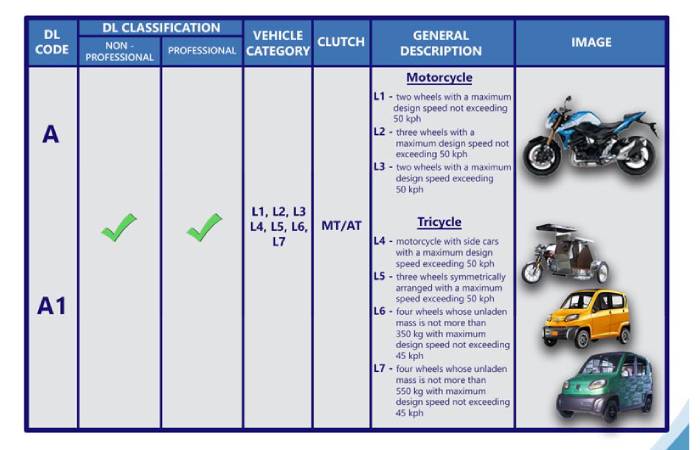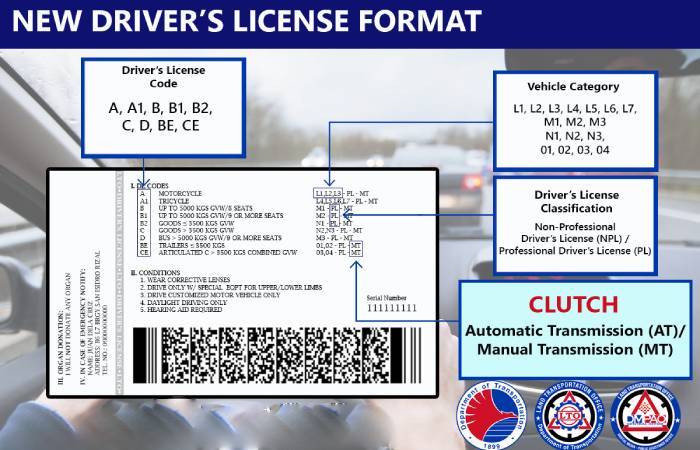Can You Drive A Motorcycle If Your License Bears Dl Code B?
Can You cannot drive a motorcycle if your license bears DL code B-DL code B is for cars and light trucks, while DL code A is for motorcycles. If you are caught driving a motorcycle with a DL code B license, you will be fined, and your license may be suspended.
To legitimately work a vehicle, you must have a particular driving permit code that compares to the vehicle’s category. According to the law, driving permit code B is assigned for vehicles weighing no more than 5000kg with a seating capacity of 8 or underneath, and it compares to vehicle category code M1.
Additionally, there’s a driving permit code B1, which is required for driving all sorts of jeepneys utilized for traveler transportation. It compares to the vehicle category M2, which incorporates traveler vehicles with a seating capacity of more than eight and a net vehicle weight not surpassing 5000kg.
Lastly, driving permit code B2 is required to operate commercial four-wheeled vehicles utilized for cargo transportation. It compares to the vehicle category code N1, which alludes to vehicles used for transporting merchandise with the highest net vehicle weight not surpassing 3500kg.
| Driving License Code | Vehicle Category Code | Vehicle Category Description
|
| B | M1 | Vehicles up to 5,000 kg GVW with not more than 8 passenger seats
|
| B1 | M2 | Vehicles up to 5,000 kg GVW with more than 8 passenger seats
|
| B2 | N1 | Vehicles carrying goods up to 3,500 kg GVW
|
What Is B Category License?

The meaning of a “B category license” can vary depending on the country in which it is issued. Here are some possible interpretations:
1. Driving License:
- Most common: In many countries, including the UK, India, and Canada, a B-category license is the most common driving license for cars and light vans. It allows you to drive vehicles with a maximum weight of 3,500 kg (7,716 lbs) and a maximum of 8 passenger seats.
- Subcategories: Some countries further subcategorize B licenses. For example, in Europe, there are B1, B2, and B3 licenses for different types of vehicles.
2. Other Licenses:
- Aviation: In some countries, like Australia, a B-category license is for piston-engine non-pressurized airplanes with a Maximum Take-off Mass (MTOM) of 2,000 kg or less.
- DoT License (India): In India, the Department of Telecommunications (DoT) uses a B-category license for Areas of Service under a Unified License.
- Other professions: Sometimes, B-category licenses may be used for specific occupations, like private investigators or alcohol vendors.
- Therefore, when asking about a B-category license, it is crucial to specify the country or region to receive an accurate interpretation.
Some points to note:
- The specific requirements for obtaining a B-category license may vary.
- The validity period of a B-category license can also differ depending on the issuing authority.
- It is always best to check with the relevant authorities for your area’s latest information and regulations regarding B-category licenses.
How Do I Get A Class B License In PA?
Eligibility:
- Be at least 18 years old.
- Hold a valid driver’s or learner’s permit for Class A or B.
- Pass a vision test.
- Pass a medical examination from a certified medical examiner.
- Complete a Commercial Learner’s Permit (CLP) application (DL-31CD).
- Pay the required fees.
Steps:
- Apply for a CLP:
- Visit your local PennDOT Driver License Center.
- Complete the DL-31CD application.
- Provide required documents (valid driver’s license, proof of age and identity).
- Pay the application fee.
- Pass the vision test.
- Complete Commercial Driver’s License (CDL) Knowledge Tests:
- Pass the General Knowledge Test for Classes A, B, and C.
- Pass any additional knowledge tests specific to the vehicle type you plan to operate (e.g., air brakes, combination vehicles).
- Complete CDL Skills Tests:
- Schedule a skills test appointment with a PennDOT Driver License Center or a third-party testing program.
- You will be tested on your ability to operate the vehicle safely and correctly according to CDL standards.
- Skills tests vary depending on the vehicle type.
- Apply for your CDL:
- Once you pass all the knowledge and skills tests, you can apply for your CDL at a PennDOT Driver License Center.
- Pay the issuance fee.
- You will receive your Class B CDL shortly after.
Things to keep in mind:
- The process can take several weeks to complete, so start early.
- Consider enrolling in a CDL training program to prepare for the knowledge and skills tests.
- Check the PennDOT website for the latest information and updates on CDL requirements.
What is an operator license?
The term “operator license” can have several meanings depending on the context. Here are some of the most common uses:
1. Commercial Driver’s License (CDL):
In many jurisdictions, a CDL is an operator license required to operate large commercial vehicles such as trucks and buses. The specific types of vehicles covered by a CDL and the requirements for obtaining one vary depending on the issuing authority.
2. Goods Vehicle Operator Licence (GVOL):
In the UK and certain other countries, a GVOL is a license required to operate goods vehicles above a certain weight for hire or reward. This license ensures that operators meet necessary safety, maintenance, and financial standing standards.
3. Private Hire Vehicle (PHV) Operator Licence:

Similar to a GVOL, a PHV operator license requires in some jurisdictions for individuals or companies operating vehicles for hire or reward that carry passengers (e.g., taxis, limousines).
4. Passenger-Carrying Vehicle (PCV) Operator Licence:
Also known as an O-licence, a PCV operator license is required in the UK and some other countries to operate vehicles carrying passengers for hire or reward, such as buses and coaches.
5. Occupational Licenses:
An operator license may be required to operate specific equipment or machinery in certain professions. Examples include heavy machinery operators, crane operators, and amusement ride operators.
6. Radio Operator License:
In some countries, a radio operator license requires to operate certain types of radio equipment, such as amateur radio or marine radio.
7. Other uses:
The term “operator license” can also be used in various other contexts, such as for licenses required to operate certain types of businesses, fishing licenses, and licenses for recreational activities.
Therefore, to understand the specific meaning of an “operator license,” it is crucial to consider the context in use. It is always best to consult the relevant authorities for clarification if you are unsure.
CONCLUSION
According to the law, driving permit code B assigns for vehicles weighing no more than 5000kg with a seating capacity of 8 or underneath, and it compares to vehicle category code M1. It corresponds to the vehicle category M2, which incorporates traveler vehicles with a seating capacity of more than eight and a net vehicle weight not exceeding 5000kg. It compares to the vehicle category code N1, which alludes to vehicles utilized for transporting merchandise with the highest net vehicle weight not surpassing 3500 kilograms. The specific types of vehicles covered by a CDL and the requirements for obtaining one vary depending on the issuing authority.
READ ALSO: Đại Học Thương Mại